| |
Cadenza
|
|
Crescendo
|
| December
1901
|
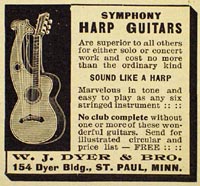

|
 The very first Dyer & Bro.
harp guitar advertisement known, other than the mention in Knutsen's
earlier illustrated flyer.
The very first Dyer & Bro.
harp guitar advertisement known, other than the mention in Knutsen's
earlier illustrated flyer.
Does it depict a
Knutsen Symphony harp guitar or the first Larson-built Dyer
Type 1?
This ad ran
monthly through August, 1903. It was absent for 5 months, then returned (exactly the same) in
February, 1904 and
ran again through November.
The
exact same ad also ran monthly in the year 1904 in The
Metronome (an unusual choice, as it was not part of the
"BMG scene"). A Dyer ad also appeared in
S. S. Stewart's Banjo & Guitar Journal in the January
and May issues of 1902, but I have not yet examined
these. While I would love to discover a new clue, I
rather expect that I'll find this same ad.
 Excerpt from "Trade
Department"
Excerpt from "Trade
Department"
As is typical,
nothing can be gleaned from the verbiage in this monthly column.
Note how the copywriter assumes that the instrument was
"made by" the Dyer Company.
|
The
Crescendo had not yet been created
. |
| October 1903
|
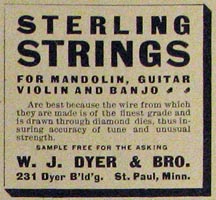
|
 During the 5 month harp guitar hiatus,
Dyer ran this ad for their Sterling Strings 4 months in a
row, starting in October.
During the 5 month harp guitar hiatus,
Dyer ran this ad for their Sterling Strings 4 months in a
row, starting in October.
|
|
| December
1904
|
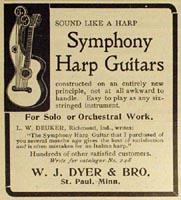 |
 The long-running Type 1 ad was
immediately replaced with this one depicting what appears to
be the typical Type 2 model. No fanfare of any kind
accompanies this momentous occasion, other than that the ad
was moved from its long-standing placement in the back pages
to the front of the magazine. They
didn't even get their usual mention in the Trade Department
- they would the next month, but only the usual generic
mention.
The long-running Type 1 ad was
immediately replaced with this one depicting what appears to
be the typical Type 2 model. No fanfare of any kind
accompanies this momentous occasion, other than that the ad
was moved from its long-standing placement in the back pages
to the front of the magazine. They
didn't even get their usual mention in the Trade Department
- they would the next month, but only the usual generic
mention.
Note the
endorsement, which must have been referring to a Type 1
Dyer.
It ran until
January, 1906. No Dyer ads then appeared from February
to October.
|
.
.
|
| November
1906
|
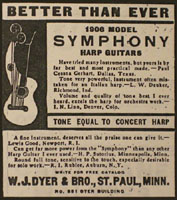
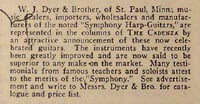
|
 After an 8-month hiatus, the
Type 2 returned. Or did it? The ad now reads
"Better than ever" and "1906 model."
What does this mean?!
After an 8-month hiatus, the
Type 2 returned. Or did it? The ad now reads
"Better than ever" and "1906 model."
What does this mean?!
If it was an
improved instrument, wouldn't you think they could spring
for a new image? This is the exact same woodcut from
the 1904 ad, now reduced to very low contrast and
resolution.
This ad ran
through August, 1907; September began another hiatus.
 Excerpt from "Trade
Department"
Excerpt from "Trade
Department"
I never make any
make assumptions from the so-called "trade news."
Here again, the copywriter was only "parroting"
what the ad boasted; it is not corroboration
of any provenance.
Curiously, in January, 1907, a Dyer ad appeared in the
American Music Journal, stating "1907 Symphony Harp
Guitars" (Noonan, 2009). I have yet to examine the
image.
|
.
.
|
| September 1907
|
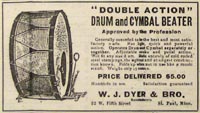
|
 No harp guitar ads appeared from September, 1907 through
December, 1907 (at which time Cadenza went on hiatus).
Instead, they first ran this "double drum beater" ad
(!).
No harp guitar ads appeared from September, 1907 through
December, 1907 (at which time Cadenza went on hiatus).
Instead, they first ran this "double drum beater" ad
(!).
|
|
| October 1907
|

|
 The next three issues included this ad for their Stetson
brand, showing a rather pedestrian "bowlback" mandolin.
The next three issues included this ad for their Stetson
brand, showing a rather pedestrian "bowlback" mandolin.
|
|
| July
1908
|
Cadenza
returns, but Dyer absent |
 After the December, 1907 issue, Cadenza disappeared for six
months. It returned in July, 1908 under new ownership -
Walter Jacobs, a Guild member. While the Cadenza had
originally been the "official organ" of the American Guild of Banjoists,
Mandolinists and Guitarists, which had formed slowly
during the early 1900's, there was obviously some sort of
rivalry going on, and the Guild hierarhcy decided to create a
new "offiical organ, The Crescendo.
Curiously, Dyer did not advertise in the first issue of the
newly revamped Cadenza.
After the December, 1907 issue, Cadenza disappeared for six
months. It returned in July, 1908 under new ownership -
Walter Jacobs, a Guild member. While the Cadenza had
originally been the "official organ" of the American Guild of Banjoists,
Mandolinists and Guitarists, which had formed slowly
during the early 1900's, there was obviously some sort of
rivalry going on, and the Guild hierarhcy decided to create a
new "offiical organ, The Crescendo.
Curiously, Dyer did not advertise in the first issue of the
newly revamped Cadenza.
 The Crescendo made its
debut. This was now the "official organ" of the
American Guild of Banjoists,
Mandolinists and Guitarists, which included many of the
same members and ran very similar articles and ads as
Cadenza had been, and would continue to do. For the most part, it overtook The
Cadenza in the BMG world, the latter changing direction by
catering more to the piano community (and then back again).
Dyer began advertising in the very first issue, with the old
Cadenza woodcut and a general announcement. Note the
mention of five bass strings. This ad ran for three
months.
The Crescendo made its
debut. This was now the "official organ" of the
American Guild of Banjoists,
Mandolinists and Guitarists, which included many of the
same members and ran very similar articles and ads as
Cadenza had been, and would continue to do. For the most part, it overtook The
Cadenza in the BMG world, the latter changing direction by
catering more to the piano community (and then back again).
Dyer began advertising in the very first issue, with the old
Cadenza woodcut and a general announcement. Note the
mention of five bass strings. This ad ran for three
months.
|
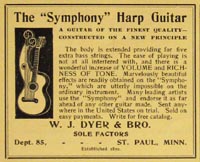 |
| September
1908
|
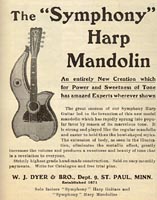
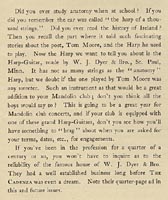
|
 While Dyer continued to
run the harp guitar ad in the new Crescendo, they renewed the
Cadenza campaign with this intriguing ad. For a
variety of reasons (discussed on the Dyer Mandolin page) I
am inclined to believe that their harp mandolin was indeed
an "entirely new creation" at this time.
In fact, I think we are looking at a single prototype
instrument - built and shown to enough of an audience to
warrant the (exaggerated) claim of being a "revelation
to everyone" that has "rapidly sprung into popular
favor." This model - with the body points on
opposite corners - has never been seen outside this ad.
Why not? I have a theory on the Dating
page. This ad only appeared in the next two issues
(and only in Cadenza) then disappeared.
While Dyer continued to
run the harp guitar ad in the new Crescendo, they renewed the
Cadenza campaign with this intriguing ad. For a
variety of reasons (discussed on the Dyer Mandolin page) I
am inclined to believe that their harp mandolin was indeed
an "entirely new creation" at this time.
In fact, I think we are looking at a single prototype
instrument - built and shown to enough of an audience to
warrant the (exaggerated) claim of being a "revelation
to everyone" that has "rapidly sprung into popular
favor." This model - with the body points on
opposite corners - has never been seen outside this ad.
Why not? I have a theory on the Dating
page. This ad only appeared in the next two issues
(and only in Cadenza) then disappeared.
This was also the
first appearance of the tern "sole factors," which
we take to mean "agents." Note also that
they now specifically use "Symphony" in quotes
unlike all earlier ads, a practice they would do
consistently for the remainder of production.
I believe these clues have specific meaning to our study,
but interpreting what exactly they signify is proving
elusive.
 Excerpt from "Trade
Notes":
Excerpt from "Trade
Notes":
Nothing special
here, other than Cadenza's new editor Walter Jacobs took
over original editor Clarence Partee's Trade
column, and he was hilarious - coming up with a completely different
long-winded and irrelevant introduction for each of the
manufacturers advertising in the issue. He did this month after month!
Did the reader now feel like they were at least getting their
money's worth with new information and a new perspective on
the brands?
|
. |
| October
1908
|
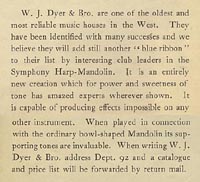 |
 Using the same woodcut, Dyer
reworded the Crescendo ad and specifically mentioned that
"flats are as easy as any other key."
This might seem to indicate that they were not using Knutsen's
original GABCD sub-bass tuning, but were using some other
tuning. However, I am convinced it is simply an indication that
Dyer's instructions recommended and directed one on how to tune individual basses down
a half step as needed to accommodate any key. This
would lend accuracy and truth to the claim that "they
give you an open bass for every chord in any key"
(specifically, retune to achieve the necessary pitches for
the standard I, IV, V, II and VI chords in any key - 5 notes
would just do it, if they suggested the G could go
down to either F# or F).
This ad ran one more month.
Using the same woodcut, Dyer
reworded the Crescendo ad and specifically mentioned that
"flats are as easy as any other key."
This might seem to indicate that they were not using Knutsen's
original GABCD sub-bass tuning, but were using some other
tuning. However, I am convinced it is simply an indication that
Dyer's instructions recommended and directed one on how to tune individual basses down
a half step as needed to accommodate any key. This
would lend accuracy and truth to the claim that "they
give you an open bass for every chord in any key"
(specifically, retune to achieve the necessary pitches for
the standard I, IV, V, II and VI chords in any key - 5 notes
would just do it, if they suggested the G could go
down to either F# or F).
This ad ran one more month.
 Excerpt from "Trade
Notes": The Cadenza writer finally read the ad that they
were running a second time. I suspect that he had no
idea whether the harp mandolin was truly new, something
common, or even in production.
Excerpt from "Trade
Notes": The Cadenza writer finally read the ad that they
were running a second time. I suspect that he had no
idea whether the harp mandolin was truly new, something
common, or even in production.
|
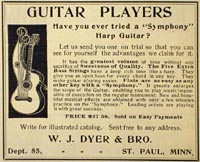 |
| December
1908
|
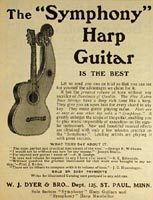 |

 The old woodcut was replaced with one of an actual 5-bass
Style 8 specimen. Unfortunately, a reversed image was
sent to both magazines. The text is identical in both
ads, with Cadenza adding six testimonials.
The old woodcut was replaced with one of an actual 5-bass
Style 8 specimen. Unfortunately, a reversed image was
sent to both magazines. The text is identical in both
ads, with Cadenza adding six testimonials.
Note the
"Department" number on the address. Using
different numbers for different magazines was a common practice - a simple means of
telling which advertising source solicited the response.
Though the image
of the "prototype" harp mandolin was dropped, they
were still advertising "Symphony" harp mandolins
(but no image).
|
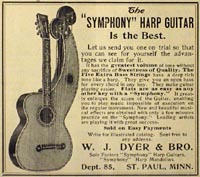 |
| January
1909
|
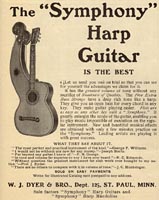 |

 The reversed image was corrected, while all text remained
the same.
The reversed image was corrected, while all text remained
the same.
The Cadenza
version ran continuously through April, 1910, the Crescendo
version ran monthly also, but went through subtle changes as
seen below.
|
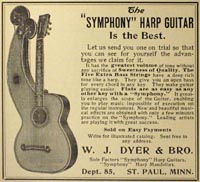 |
|
May
1909
|
Above ad still
running |
 The ad text was replaced with the six testimonials from
1908. Strangely, the listed harp mandolin was now
dropped from Cresendo ads, though Cadenza would keep running
the January ad which included it. Yes, I have
hypothetical scenarios for all of this as well on the Dating
and Dyer Mandolin pages. Note that they
also dropped the "sole
factor" claim. This
ad continued monthly.
The ad text was replaced with the six testimonials from
1908. Strangely, the listed harp mandolin was now
dropped from Cresendo ads, though Cadenza would keep running
the January ad which included it. Yes, I have
hypothetical scenarios for all of this as well on the Dating
and Dyer Mandolin pages. Note that they
also dropped the "sole
factor" claim. This
ad continued monthly.
|
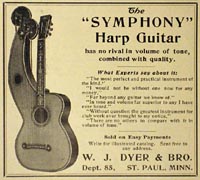 |
|
July
1909
|
Above ad still
running |
 Crescendo mentions receiving a (presumably new) Dyer
catalog, which includes complete descriptions of the harp
guitars.
Crescendo mentions receiving a (presumably new) Dyer
catalog, which includes complete descriptions of the harp
guitars.
|
 |
| January
1910
|
Above ad still
running |
 The ad was revamped with text similar to that introduced in
December, 1908. Nothing new introduced.
It then continued monthly.
The ad was revamped with text similar to that introduced in
December, 1908. Nothing new introduced.
It then continued monthly.
 Other than one issue, Cadenza
ran Dyer's January, 1909 ad this entire time, and continued
for another three months.
Other than one issue, Cadenza
ran Dyer's January, 1909 ad this entire time, and continued
for another three months.
|
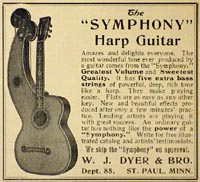 |
| February
1910
|
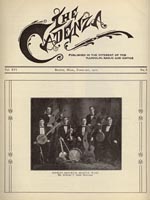 |
|
 The first actual photograph that includes a Dyer
harp guitar appeared and it was wonderful!
The group used three Dyers, and each had six
sub-basses, not five. Reading the text, it
occurred to me how well this group would have been
right at home at our Harp Guitar Gatherings.
Overall, the players' credits that accompanied
musician images like these would list
"guitar" about half the time, and
"harp guitar" the other half.
The first actual photograph that includes a Dyer
harp guitar appeared and it was wonderful!
The group used three Dyers, and each had six
sub-basses, not five. Reading the text, it
occurred to me how well this group would have been
right at home at our Harp Guitar Gatherings.
Overall, the players' credits that accompanied
musician images like these would list
"guitar" about half the time, and
"harp guitar" the other half.
|
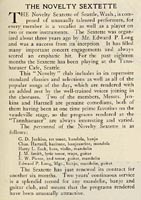
|
|
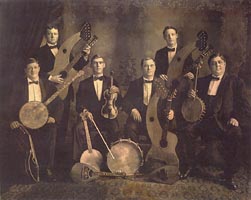
|
Here
is a better copy of the original group photo, recently
discovered and graciously shared by the anonymous
owner.
|
|
. |
| April
1910
|
Above ad still
running |
 Finally! The first mention of the Dyer tuning. It
never appeared in their ads (which is where the editors copied
their Trade Notes information from), so this editor must have
read the catalog mentioned earlier, and decided to actually
provide extra, useful information. Not surprisingly, the
tuning is the same as Knutsen's - descending D, C, B, A &
G. Even this is part guesswork (though obvious), as the
editor stupidly omits listing the D, just after mentioning the
5 bass strings. He mentions again the ease of playing in
any key, which would seem to prove my theory above.
Finally! The first mention of the Dyer tuning. It
never appeared in their ads (which is where the editors copied
their Trade Notes information from), so this editor must have
read the catalog mentioned earlier, and decided to actually
provide extra, useful information. Not surprisingly, the
tuning is the same as Knutsen's - descending D, C, B, A &
G. Even this is part guesswork (though obvious), as the
editor stupidly omits listing the D, just after mentioning the
5 bass strings. He mentions again the ease of playing in
any key, which would seem to prove my theory above.
He also mentions a
price for the harp guitars! $27 and upwards. We
can postulate that the plain Style 4 then cost this much in
1910 - unless that was the harp mandolin price, and the editor
was again being careless.
|
 |
| May
1910
|
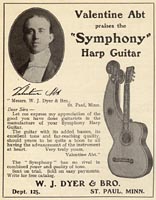 |

 Dyer got a big boost with an endorsement from Valentine Abt.
Dyer got a big boost with an endorsement from Valentine Abt.
Abt was an
unusual multi-instrumentalist "BMG" player in that
his two main instruments were the mandolin and the pedal
harp. Like most in his
field, he played and taught guitar as
well.
Abt may never
have owned or played a Dyer, but clearly had first-hand
experience hearing and assessing it, or he would not have
written his testimonial.
The two ads
featured identical text, with the same Style 8 image
continuing in Cadenza, and a lovely period illustration
appearing in Crescendo. Each continued monthly until
the next ads appeared.
|
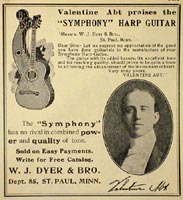 |
| September
1910
|
Above ad still
running |
 In the Q & A column, a woman asks specifically what the
tuning is for six sub-basses. The type of instrument is not
specified. The editor answers with the same Dyer 5-bass
tuning as above (though this time they at least remember the
"D"). This would seem to indicate that no new
catalog describing the new option of a 6th sub-bass has yet
been put out. In fact, despite the several other
existing brands of harp guitar with six subs (including Gibson,
who published their own tuning in 1903), and Dyer themselves offering it as an option several months prior (see Feb, 1910),
the editors had no clue what people were tuning them to.
For the 6th string, they "recommend" either F
(Gibson's) or Bb (?)! The editor does not answer the
lady's question about how to hold the harp guitar either.
In the Q & A column, a woman asks specifically what the
tuning is for six sub-basses. The type of instrument is not
specified. The editor answers with the same Dyer 5-bass
tuning as above (though this time they at least remember the
"D"). This would seem to indicate that no new
catalog describing the new option of a 6th sub-bass has yet
been put out. In fact, despite the several other
existing brands of harp guitar with six subs (including Gibson,
who published their own tuning in 1903), and Dyer themselves offering it as an option several months prior (see Feb, 1910),
the editors had no clue what people were tuning them to.
For the 6th string, they "recommend" either F
(Gibson's) or Bb (?)! The editor does not answer the
lady's question about how to hold the harp guitar either.
|
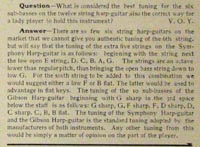 |
| November
1910
|
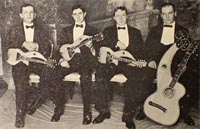
Another 6-bass Dyer (looks like
a brand new Style 7)
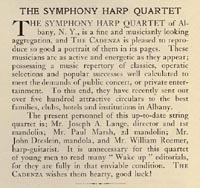
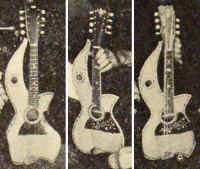
|
 Aha! A "smoking gun"? The second dated
appearance of Dyer instruments offers evidence, clues,
frustrations and one red herring.
Aha! A "smoking gun"? The second dated
appearance of Dyer instruments offers evidence, clues,
frustrations and one red herring.
For evidence, we have proof that the Dyer harp mandolin - in
its standard form, not the 1908 "prototype" form - was being
built and sold by this time.
Exactly when is
of course impossible to say - we have to factor in the lead
time of the photo's submission to the editor to the printing
date, and how well the November "street date" matched up
with the calendar month for these periodicals. The
group could have been in existence for some time, or they
could have unpacked their Dyer shipment, thrown on their
tuxes and snapped an immediate photo for a hopeful magazine
spot (I certainly would have!). In any event, the
instruments were certainly available in numbers by early
Fall of 1910 at a minimum.
The important
thing is where it falls in line with the two early harp
mandolin patents. This photo appears smack in-between the expiration dates of the
Gaskin patent and the Livermore
patent. Is it a clue? If so, it is sure a
frustrating one! (see the Dyer
mandolin page)
The red herring
is the mention of the instrumentation, which includes
"two mandolins and mandola" When my
Cadenza-research associate, Paul Ruppa, sent me a copy of
this many years back, I remember thinking "how cool - a
group with all Dyers, including a mandola!"
Later, I realized something was odd, so when re-visiting it
again during my Dyer Dating re-investigation, I carefully
assembled the three instruments in Photoshop to compare,
without changing scale. I'm not a forensic expert, but
I attribute the slight variation in size and scale length to
each instrument's relationship to the camera - some are
tilted much more than others. The center one looks a
bit shorter, but I think it's an illusion of perspective - I
don't think the Larsons built a mandolin with a slightly
shorter scale than their normal X" (though who knows?).
None are a true mandola, which would have had not only a
notably longer scale, but a very different body shape - as
will be seen further down the page when they actually were
introduced.
No, I think the
group simply wanted the quartet to match (note how they
honored Dyer with the name "Symphony Harp
Quartet"), and, with no harp mandola yet being
available, the player simply strung and tuned his Dyer
mandolin to tenor mandola pitch.
|
. |
| February
1911
|
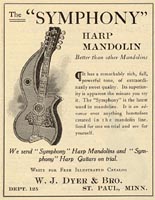 |

 The harp mandolin came back, and this time it was the actual
production model, which we know from the previous photograph
and a dated specimen that it was available at least a few months,
and likely a year or two prior.
The harp mandolin came back, and this time it was the actual
production model, which we know from the previous photograph
and a dated specimen that it was available at least a few months,
and likely a year or two prior.
There was nothing
about a "new model," and "sole factors"
had been previously abandoned.
This must have
been the Dyer harp mandolin's heyday - while the Crescendo
ad ran continuously for 11 months, the Cadenza ad ran
monthly for a staggering 47 months!
|
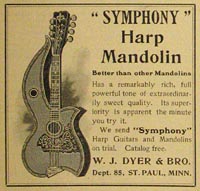 |
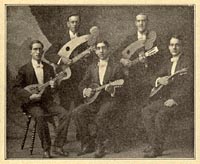 |
|
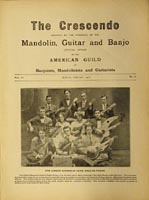 |
| December
1911
|
Above ad still
running |
 In Questions & Answers, someone enquires as to who was
making mandolas. The Crescendo editors certainly don't
list all the manufacturers, but do mention Dyer - who was
almost certainly not making the harp mandola yet. I
think this is a red herring, with the editor either making a
mistake, or referring to a Stetson or other non-Dyer brand
standard non-harp mandola they knew from a Dyer
catalog.
In Questions & Answers, someone enquires as to who was
making mandolas. The Crescendo editors certainly don't
list all the manufacturers, but do mention Dyer - who was
almost certainly not making the harp mandola yet. I
think this is a red herring, with the editor either making a
mistake, or referring to a Stetson or other non-Dyer brand
standard non-harp mandola they knew from a Dyer
catalog.
|
 |
| January
1912
|
Above ad still
running |
 A new variant on the earlier harp guitar ads, still with
only five basses advertised. This ad perhaps had a 3-year contract; it ran for exactly 36 months.
A new variant on the earlier harp guitar ads, still with
only five basses advertised. This ad perhaps had a 3-year contract; it ran for exactly 36 months.
|
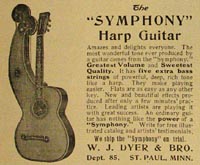 |
| February
1912
|
Above ad still
running |
|
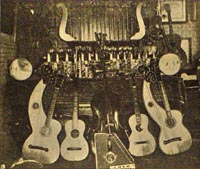
|
 This nice group of instruments was insured for
$1000 in 1912. Wonder how much of that was
the Style 8? The Style 8 has six subs, the
Style 4 (?) has five.
This nice group of instruments was insured for
$1000 in 1912. Wonder how much of that was
the Style 8? The Style 8 has six subs, the
Style 4 (?) has five. |
|
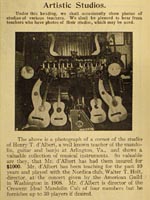 |
| May
1913
|
Above ad still
running |
 The Boston Ideals, with a six-bass Style 5 or 6.
The Boston Ideals, with a six-bass Style 5 or 6.
|
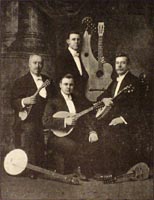 |
| June
1914
|
Above ad still
running. |
 Though no new ads have appeared, or would for awhile,
mention is made of a new catalog received at the Crescendo
offices.
Though no new ads have appeared, or would for awhile,
mention is made of a new catalog received at the Crescendo
offices.
|
 |
| January
1915
|
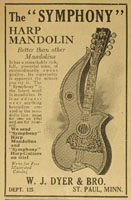 |
 For reasons unknown, on the last month of the harp
mandolin's 4-year ad campaign, Cadenza re-vamped the ad
slightly - and then Dyer immediately retired it; this only
appeared once.
For reasons unknown, on the last month of the harp
mandolin's 4-year ad campaign, Cadenza re-vamped the ad
slightly - and then Dyer immediately retired it; this only
appeared once.
Dyer now stopped
advertising in the Cadenza for a full 31 months - perhaps
because the journal was now catering to pianists far more
than the original banjo, mandolin and guitar community.
 And yet...they also stopped advertising in the Crescendo -
also for exactly 31 months. What was going on with
sales and the company?
And yet...they also stopped advertising in the Crescendo -
also for exactly 31 months. What was going on with
sales and the company?
|
.
|
| July
1917
|
Ads still
absent |
|

|
 Another brave Dyer
player in an almost exclusive Gibson orchestra. What did the two harp guitarists
think of each other's instruments, I wonder...?
Another brave Dyer
player in an almost exclusive Gibson orchestra. What did the two harp guitarists
think of each other's instruments, I wonder...? |
|
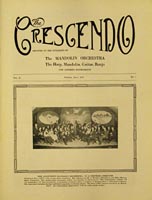 |
| August
1917
|
Ads still
absent |
 After over 2-1/2 years, Dyer was back, and with a vengeance.
They returned with the classic harp guitar with a fine print
mention of the harp mandolins and now mandolas and
mandocellos! This rather low key ad continued monthly.
Note that they now (finally) listed six sub-basses as
standard.
After over 2-1/2 years, Dyer was back, and with a vengeance.
They returned with the classic harp guitar with a fine print
mention of the harp mandolins and now mandolas and
mandocellos! This rather low key ad continued monthly.
Note that they now (finally) listed six sub-basses as
standard.
|
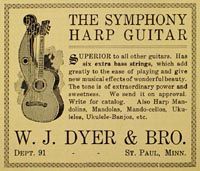 |
| September
1917
|
 |
 Meanwhile, a much more elaborate Cadenza campaign began a month later
in the Cadenza, which in the interim seems to have given up
on their piano focus and returned to serving the interests of
its original core group. In fact, it, rather than the
Crescendo, is now the "official organ of the American
Guild of Banjoists, Mandolinists and Guitarists. The
first Cadenza ad echoed Crescendo's - perhaps they wanted to
remind everyone first of the successful harp guitar?
Meanwhile, a much more elaborate Cadenza campaign began a month later
in the Cadenza, which in the interim seems to have given up
on their piano focus and returned to serving the interests of
its original core group. In fact, it, rather than the
Crescendo, is now the "official organ of the American
Guild of Banjoists, Mandolinists and Guitarists. The
first Cadenza ad echoed Crescendo's - perhaps they wanted to
remind everyone first of the successful harp guitar?
 As we have seen, the Trade column rarely offered any real
corroboration or new information. However, in this
case, the editor did not simply place an ad, but made
mention of receiving the new catalog. They note the
"new" mandolas and mandocellos also. While
the writer may not have been familiar with Dyer's full
production, I would think that they were indeed reporting
correctly the information in the catalog itself - that Dyer
was introducing the new mandolas and mandocellos for the
first time. Also, despite the ads not picturing the
new instruments until a bit later, we can assume that they
were already fully illustrated in the new catalog, and thus
had been designed and built well prior to this (at least one
of each).
As we have seen, the Trade column rarely offered any real
corroboration or new information. However, in this
case, the editor did not simply place an ad, but made
mention of receiving the new catalog. They note the
"new" mandolas and mandocellos also. While
the writer may not have been familiar with Dyer's full
production, I would think that they were indeed reporting
correctly the information in the catalog itself - that Dyer
was introducing the new mandolas and mandocellos for the
first time. Also, despite the ads not picturing the
new instruments until a bit later, we can assume that they
were already fully illustrated in the new catalog, and thus
had been designed and built well prior to this (at least one
of each).
|
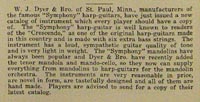
|
| October
1917
|
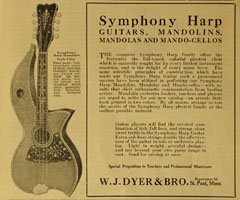 |
 Rather than re-running ads as was common, Dyer rolled out
the new "harp plectral quartet" (or "quintette")
family in fairly quick succession - each would run just
once. First up was the mandolin, which had been
available now for several years. The following month, they
re-ran the previous harp guitar ad.
Rather than re-running ads as was common, Dyer rolled out
the new "harp plectral quartet" (or "quintette")
family in fairly quick succession - each would run just
once. First up was the mandolin, which had been
available now for several years. The following month, they
re-ran the previous harp guitar ad. |
.Above ad
missing from this one issue |
| December
1917
|
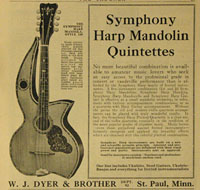 |
 In December, they showed the harp mandola. Note the model, which is "Style 145."
In December, they showed the harp mandola. Note the model, which is "Style 145." |
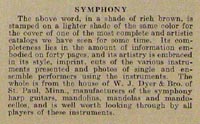
|
|
The journals rarely singled out an advertiser, but Cadenza made
a rare exception here to rave about the Dyer catalog. I
would kill to find a copy! |
|
Above ad still
runningv.
. |
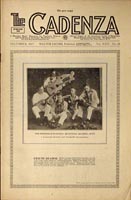 |
 Knutsen and Dyer harp guitars were popular with
Hawaiian groups from the inception of America's
Hawaiian music craze - perhaps due in no small
part to Knutsen having created America's first
acoustic steel guitars side by side with America's
first hollow-arm harp guitars in the early 1900's.
Knutsen and Dyer harp guitars were popular with
Hawaiian groups from the inception of America's
Hawaiian music craze - perhaps due in no small
part to Knutsen having created America's first
acoustic steel guitars side by side with America's
first hollow-arm harp guitars in the early 1900's. |
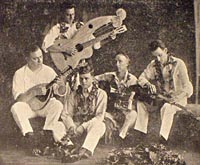
|
| Look
closely: Frederick's Hawaiian Quintette contains two
harp guitarists - one with a 6-bass Dyer Style 5
or 6, the other with a somewhat common doubleneck
with a metal headstock joining bracket, a model
sold under many different brands (see Gallery
Form 2b). |
|
| January
1918
|
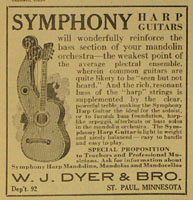 |
 Back to a new harp guitar ad. This one I find interesting,
as they actually referred to the sub-basses as
"harp" strings, which would help the player create
"harp-like arpeggii" and "bass solos."
Back to a new harp guitar ad. This one I find interesting,
as they actually referred to the sub-basses as
"harp" strings, which would help the player create
"harp-like arpeggii" and "bass solos." |
Above ad still
running. |
| February
1918
|
 |
 Last but not least, the harp mandocello was featured.
Note the model, labeled "Style 250."
Last but not least, the harp mandocello was featured.
Note the model, labeled "Style 250." |
Above ad still
running |
| March
1918
|
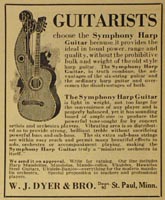 |
. Another newly worded harp guitar appeared but only ran once.
Another newly worded harp guitar appeared but only ran once. |
Above ad still
running. |
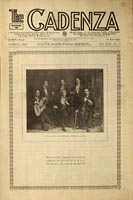 |
 L. Linn's Orchestra, whose harp guitarist played a
5-bass Dyer (Style 7?).
L. Linn's Orchestra, whose harp guitarist played a
5-bass Dyer (Style 7?). |
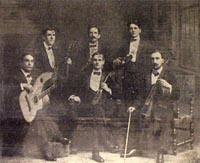
|
|
| April
1918
|
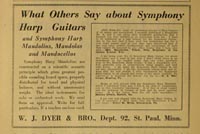 |
 One last gasp in Cadenza. This text-only ad
appeared just once.
One last gasp in Cadenza. This text-only ad
appeared just once.
|
.Above ad still
running |
|
June
1918
|
Ad campaign
over |
 Dyer continues advertising the line in Crescendo with three
more updated ads over the next few months. This ran 2
months.
Dyer continues advertising the line in Crescendo with three
more updated ads over the next few months. This ran 2
months.
|
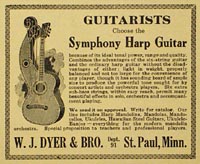 |
|
August
1918
|
Ad campaign
over |
 This ran 3 months.
This ran 3 months.
|
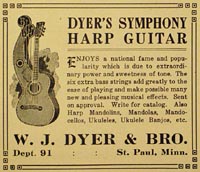 |
|
November
1918
|
Ad campaign
over |
. This final illustrated ad ran for 9
months.
This final illustrated ad ran for 9
months. |
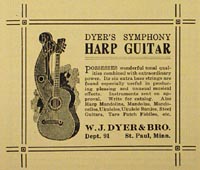 |
|
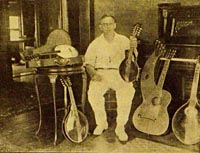
|
Mr. Emendorfer was
apparently around since the very beginning of
America
’s Mandolin Club craze.
Nearly thirty years later, he had learned
all the BMG instruments, taught and organized
various groups, and had amassed a nice little
collection, including a 5-bass Dyer (Style 5 or
6). He
sent in his photo and bio only to tell readers
that he was retiring to devote all his time to
making guns. |
|
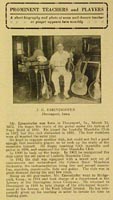 |
| August
1919
|
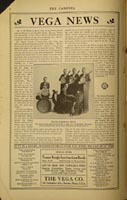 |
|
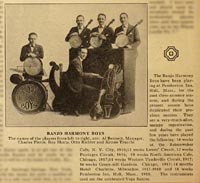
|
 I love the photo in this Vega ad, and not just
because the Banjo Harmony Boys are described
(accurately I am sure) as “very-much-alive”
and “snappy.”
Another cool dual harp guitar group, with a
6-bass Dyer and a rare Almcrantz, perhaps a twin
to this
one.
I love the photo in this Vega ad, and not just
because the Banjo Harmony Boys are described
(accurately I am sure) as “very-much-alive”
and “snappy.”
Another cool dual harp guitar group, with a
6-bass Dyer and a rare Almcrantz, perhaps a twin
to this
one. |
|
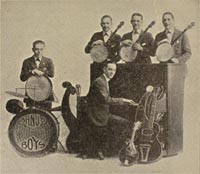
|
 The reign of Dyer harp guitars and the harp
plectral quartet was over - though they still
mention the availability while they introduced (or
promoted) their "Sterling Strings." This ad ran
two more times.
The reign of Dyer harp guitars and the harp
plectral quartet was over - though they still
mention the availability while they introduced (or
promoted) their "Sterling Strings." This ad ran
two more times.
|
|
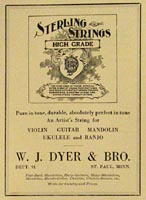 |
| October
1919
|
Ad campaign
over |
 And then there were none. The harp guitar and mandolin
orchestra heyday had not ended by any means, but the
"craze" had ended and manufacturers no
longer seemed to bother pursuing that clientele. Dyer
now turned briefly to ukulele music. After running the
string ad just once more, they ran this uke method ad for 8
consecutive months.
And then there were none. The harp guitar and mandolin
orchestra heyday had not ended by any means, but the
"craze" had ended and manufacturers no
longer seemed to bother pursuing that clientele. Dyer
now turned briefly to ukulele music. After running the
string ad just once more, they ran this uke method ad for 8
consecutive months.
|
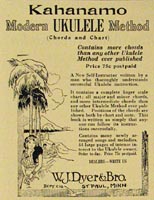 |
| May
1920
|
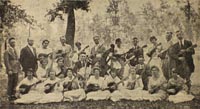 |
. I don't have a record of the exact Cadenza issue this small
image appeared in, but even better, the text mentions the
exact day the photo was taken (May 23, 1920). Yet
another Dyer player sneaks into an otherwise all-Gibson
mandolin group.
I don't have a record of the exact Cadenza issue this small
image appeared in, but even better, the text mentions the
exact day the photo was taken (May 23, 1920). Yet
another Dyer player sneaks into an otherwise all-Gibson
mandolin group. |
Above ad
running |
| November
1923
|
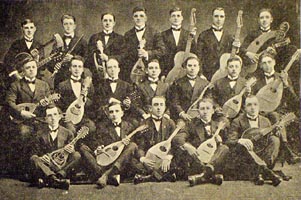 |
 Gibson and Dyer harp guitars continued to battle it out
within the same group in
the pages of the BMG journals. The interesting
6-string guitars remind me of the New York Italian
Puntolillo harp guitars found.
Gibson and Dyer harp guitars continued to battle it out
within the same group in
the pages of the BMG journals. The interesting
6-string guitars remind me of the New York Italian
Puntolillo harp guitars found.
|
Ad campaign
over |
| February
1925
|
Ad campaign
over |
|
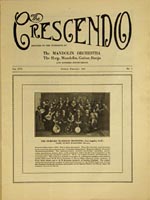 |
| A
note of appreciation and thanks. Many years
ago, a
near-complete run (95% complete) of both Cadenza and
Crescendo was donated to the International Guitar Research
Archives at CSUN (a short drive from my home). A big
thanks to Dr. Ron Purcell and staff for allowing us access
to document this priceless material. The collection
(of which these journals were just a small part) came from the
estate of Valdah Olcott Bickford (far right in the both photographs). She and her husband
Zahr Myron Bickford were key (and colorful) figures in the
BMG movement for decades and made numerous contributions to
the journals over the years.
|
|
The
BMG Movement refers to a time before radio (does
anyone reading this article even remember such a thing?)
when Americans entertained themselves by making music.
The most popular were the main instruments in the fretted strings
family: the Banjo, Mandolin and Guitar.
Over the four to five decades that Americans enjoyed this pastime,
numerous journals were created to cater to the many
thousands of mostly amateur
musicians. Sometimes new journals were started by instrument
manufacturers like banjo maker S. S. Stewart (Stewart's
Banjo Journal) or music publishers like F. O. Gutman (The
F.O.G. Journal). There were about a dozen
different publications in total. Some came and went in just a few issues, while
others became indispensable to the plectral community.
The two biggest of these were The Cadenza and The
Crescendo.
Other than certain dedicated
musicians or instrument collectors that learned of these
magazines and tracked them down for musical and historical
research, the larger musical public has almost no awareness
of this important musical era. Harpguitars.net readers have naturally
been exposed to it, as the period - reflected in these
periodicals - was the heyday of the American harp
guitar. In fact, the more research one does, the more
one realizes how normal and even indispensable these
now-rare instruments actually were.
The best and virtually only
book (other than thesis's by researchers Paul Ruppa and
Scott Hambly) in which to learn about this era is Jeffrey Noonan's The
Guitar in America, published in 2008. His
2009 bibliography The Guitar in American Banjo, Mandolin
and Guitar Periodicals, 1882-1933 provided me with
many additional harp guitar entries that I might have
otherwise easily overlooked. Thanks for your
passion, Jeff!
- Gregg Miner
|
|
Updates:
March, 2010: Added the October 1903 string ad, the July
1909 catalog mention, and the April and September 1910 tuning
mentions.
April, 2010: Added the 1907 drum ad. Clarified the 1908 Jan-July Cadenza period
(the magazine was sold and so absent for 6 months).
|
|